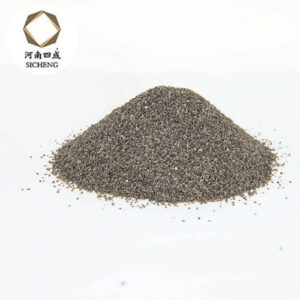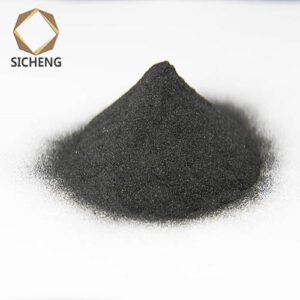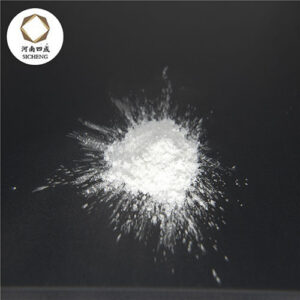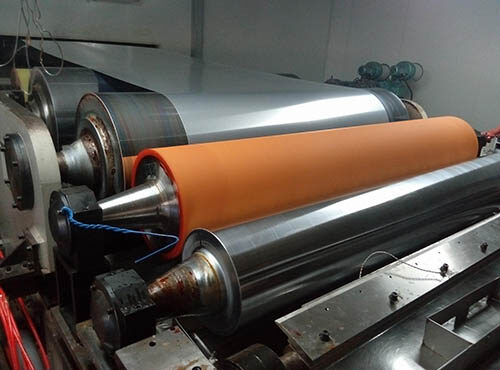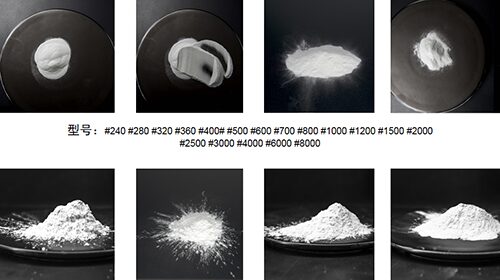¿Para cuántos usos se debe utilizar arena de corindón blanco/alúmina fundida para rellenar rodillos de caucho?
Definición de rodillo de caucho:
El rodillo de caucho es un producto en forma de rodillo hecho de metal u otros materiales como núcleo y caucho vulcanizado.
Clasificación de los rodillos de caucho:
Según el propósito, se puede dividir en: rodillos de caucho para fabricación de papel, rodillos de caucho para impresión y teñido, rodillos de caucho para impresión, rodillos de caucho para descascarillado, rodillos de caucho metalúrgicos y rodillos de caucho para mimeógrafo, etc.; según la forma de la superficie se puede dividir en:
Rodillos planos y rodillos de caucho con patrón;
Según el material, se puede dividir en: rodillo de caucho butílico, rodillo de caucho nitrilo, rodillo de caucho de poliuretano y rodillo de caucho de silicona, etc.
El rodillo de caucho generalmente se compone de caucho exterior, capa de caucho duro, núcleo de metal, cuello de rodillo y orificios de ventilación. Su procesamiento incluye chorro de arena del núcleo del rodillo, tratamiento de unión, moldeo con pegamento, envoltura, bobinado de alambre, vulcanización en tanque de vulcanización y procesamiento de superficies. Esperando el proceso. Los cots se utilizan principalmente en la fabricación de papel, impresión y teñido, impresión, procesamiento de alimentos, metalurgia, procesamiento de plástico, etc.
Las cunas a menudo se rellenan con alúmina fundida, corindón blanco de 150 mallas, 180 mallas, 220 mallas, 240 mallas, 280 mallas, 360 mallas, 400 mallas, 600 mallas, 800 mallas, 1000 mallas, 1200 mallas, 1500 mallas, 2000 mallas, 2500 mallas, 3000 mallas, 4000 mallas
Proceso de producción de rodillos de caucho y explicación técnica:
En los últimos años, las tecnologías como la inyección, la extrusión y el bobinado se han desarrollado continuamente, y los equipos de vulcanización de formación de rodillos de caucho han mecanizado y automatizado gradualmente la producción de rodillos de caucho. El rendimiento del rodillo de caucho tiene un gran impacto en toda la máquina, el funcionamiento del proceso y la calidad de producción son extremadamente estrictos, y muchos tipos de productos han sido catalogados como productos finos, de los cuales la selección de materiales de caucho y plástico y el control de la precisión dimensional del producto son la clave. La superficie de caucho del rodillo de caucho no puede tener impurezas, agujeros de arena y burbujas, y no puede haber cicatrices, defectos, ranuras, grietas y esponjas locales y fenómenos blandos y duros.
Para ello, el rodillo de caucho debe mantenerse absolutamente limpio y meticuloso durante todo el proceso de producción para lograr un funcionamiento unificado y una estandarización técnica. La unión de caucho y plástico con núcleo de metal, el pegado, el moldeo por inyección, el pulido por vulcanización y otros procesos se han convertido en procesos de alta tecnología.
Con el paso de los años, debido a la naturaleza no fija de los productos y la diversidad de especificaciones de tamaño, la mecanización y automatización de los equipos de proceso se han vuelto difíciles y, hasta ahora, la mayoría de ellos siguen siendo líneas de producción manuales de operación unitaria intermitente. Recientemente, algunos grandes fabricantes profesionales han comenzado a realizar una producción continua desde materiales de caucho hasta procesos de moldeo y vulcanización, lo que ha duplicado la eficiencia de producción y ha mejorado enormemente el entorno de trabajo y la intensidad de la mano de obra.
1. Preparación de materiales de caucho
For rubber rollers, the mixing of rubber is the most critical link. There are more than 10 kinds of rubber materials for rubber rollers from natural rubber, synthetic rubber to special materials, with a rubber content rate of 25%~85% and a hardness of soil (0~90) degrees, spanning a large range. Therefore, how to make these compounds evenly mixed has become a major problem. The conventional method is to use a mill to mix and process in the form of a variety of master compounds. In recent years, companies have increasingly switched to meshing mixers to produce rubber in segmented mixtures.
After the rubber material reaches uniform mixing, the glue filter machine is used to filter the glue to eliminate the impurities in the rubber material. Then use calender, extruder, and laminating mechanism to form film or rubber strips without bubbles and impurities for rubber roller forming. Before molding, these films and strips are also subject to strict visual inspection, limiting the parking period, maintaining a fresh surface and preventing adhesion and extrusion deformation. Because most of the rubber rollers are non-molded products, once there are impurities and bubbles on the surface rubber, there may be trachoma when grinding the surface after vulcanization, which will lead to excessive repair of the entire rubber roller or even scrap.
2. Molding
Rubber roller forming is mainly pasted and coated rubber on the metal core, including coating method, extrusion method, molding method, injection pressure method and injection method. At present, the domestic is mainly based on mechanical or manual pasting and molding, and most foreign countries have realized mechanical automation. Large and medium-sized rubber rollers are basically produced by profiling extrusion, which is produced by pressing out the film continuously pasted and forming or extruded rubber strips continuously winding and forming. At the same time, in the molding process, the microcomputer automatically controls its specifications, sizes and appearance shapes, and some can also be molded by pressing out machine right angle and special-shaped extrusion.
The above molding method can not only reduce labor intensity, but also eliminate the bubbles that may be generated. In order to prevent the deformation of the rubber roller in vulcanization and prevent the generation of bubbles and sponges, especially for the rubber roller formed by the coating method, the external method of flexible pressure should also be adopted. Usually several layers of cotton or nylon cloth are wrapped on the outer surface of the rubber roller, and then fixed and pressurized with steel wire or fiber rope. Although this process has long been mechanized, the manufacturing process is complicated by the removal of the wrapping after vulcanization, forming a «cecum» process, and causing waste due to the extremely limited number of uses of bandaging cloth and winding rope.
For small and micro rollers, a variety of production processes such as manual mounting, extrusion insertion, pressure injection, injection and pouring can be used. In order to improve production efficiency, most of the molding method is now used, and the accuracy is much higher than that of the non-molded method. Solid rubber injection, injection and liquid rubber pouring have become the most important production methods.
Third, vulcanization
At present, the vulcanization method of large and medium-sized rubber rollers is still vulcanization of vulcanization tanks, although the flexible pressurization mode has changed, but it has not been separated from the heavy labor burden of round-trip transportation and lifting. There are three heating methods for vulcanization heat sources: steam, hot air and hot water, and the mainstream is still steam. Due to the metal core contact with water vapor and have special requirements of the rubber roller, the use of indirect steam vulcanization, the time to be extended by 1~2 times, generally used for hollow iron core rubber roller. For special rubber rollers that cannot be vulcanized with vulcanization tanks, hot water is sometimes vulcanized, but the treatment of water pollution needs to be solved.
In order to prevent the rubber and metal core from shrinking differently due to the difference in thermal conductivity and causing delamination between the rubber roller and the rubber core, the general vulcanization is mostly used by slowly heating and pressurizing, and the vulcanization time is much longer than the vulcanization time required by the rubber itself. In order to achieve uniform vulcanization inside and outside and to make the thermal conductivity of metal core and rubber similar, the large rubber roller often stays in the tank for up to 24~48h, which is about 30~50 times the normal vulcanization time of rubber.
Most of the small and micro rubber rollers have now been molded and vulcanized by flat plate vulcanizing machines, completely changing the traditional vulcanization method of rubber rollers. In recent years, it has also implemented mold loading and vulcanization of injection press, and can automatically open and close the mold, and the degree of mechanization and automation has been greatly improved, and the vulcanization time is short, the production efficiency is high, and the product quality is good. Especially when using rubber injection molding vulcanizing machine, the two processes of molding and vulcanization are combined into one, and the time can be shortened to 2~4 min, which has become an important direction for the development of rubber roller production.
At present, liquid rubber represented by polyurethane elastomer (PUR) has developed rapidly in the production of rubber rollers and opened up a new way for material and process revolution. It adopts the pouring form, throwing off complex forming operations and bulky vulcanization equipment, greatly simplifying the rubber roller production process. However, the biggest problem is that due to the use of molds, for large rubber rollers, especially for individual products, the production cost is greatly increased, which brings great difficulties to the promotion and use.
In order to solve this problem, in recent years, a new process of PUR rubber roller manufacturing without mold has begun to appear. It uses polypropylene oxide ether polyol (TDIOL), polytetrahydrofuran ether polyol (PIMG) and diphenylmethane diisocyanate (MDl) as raw materials, mixes and stirs quickly reacts, quantitatively pours onto the slowly rotating rubber roller metal core, step by step to achieve solidification while pouring, and finally forms rubber roller. This process is not only short, mechanized, high degree of automation, but also eliminates the bulky mold, can be freely according to the requirements of the production of various specifications and sizes of rubber rollers, so that the cost is greatly reduced, has now become the main development direction of PUR rubber rollers.
In addition, the use of miniature fine rubber rollers in the manufacture of office automation equipment from liquid silicone rubber around the world is also developing rapidly. They are divided into two categories: heat curing (LTV) and room temperature curing (RTV), and the equipment used is also different from the PUR above, forming another type of pouring form. Here, the most critical question is how to control and reduce the viscosity of the compound so that it maintains a certain pressure and extrusion speed.
4. Surface treatment
Surface treatment is the last and most critical process in the production of rubber rollers, and the surface grinding state directly affects the performance of rubber rollers. At present, there are various grinding methods, but mainly mechanical turning and polishing, for this grinding method, grinding tools and abrasives used are very important, companies regard it as a technical know-how, maintain an unannounced attitude. One of the biggest problems is how to solve the heat generation phenomenon of rubber during grinding and maintain the optimal deflection of the surface after grinding.
Además de lijar la superficie del rodillo de goma, es necesario limpiarla a fondo para eliminar el polvo de goma adherido a la superficie. Para aquellos con mayores requisitos, la superficie debe pulirse aún más y se deben recubrir algunos revestimientos de resina, pinturas de látex y polvos magnéticos sobre la superficie. , polvo electrostático, etc. Al mismo tiempo, también se puede galvanizar una capa del revestimiento requerido o se puede realizar un tratamiento de oxidación química para lograr las funciones de sensibilidad a la luz, resistencia a la corrosión, magnetización y conductividad.
Con el desarrollo continuo de los rodillos de caucho, la tecnología de recubrimiento de la superficie de los rodillos de caucho también se ha mejorado rápidamente y ha comenzado a cambiar el método tradicional de que el rendimiento de los rodillos de caucho dependa completamente del recubrimiento de caucho. En concreto, se trata de cambiar y dar nuevas propiedades al rodillo de caucho mediante el recubrimiento. Por ejemplo, utilizando equipos como calandrias y máquinas raspadoras para agregar capas de protección de aceite para lograr el propósito de mejorar la resistencia al aceite, etc. Aunque la forma y el material de los rodillos de caucho son los mismos que antes, sus funciones han sufrido grandes cambios y algunos se han convertido en rodillos de caucho funcionales, este tipo de tecnología de tratamiento de superficies tendrá grandes perspectivas de desarrollo en el futuro.
Principales materias primas de los rodillos de caucho: polímeros de alto peso molecular como caucho, agentes vulcanizantes, plastificantes, rellenos, aceleradores.
Su flujo de proceso y función principal: mezcla-filtrado-tratamiento de curado-molienda-pulido
1. Mezcla: Controlar el contenido de cada componente, temperatura de calentamiento, etc., para que la dureza y la composición sean estables.
2. Filtración: uniformizar el coloide y eliminar las impurezas. Esto es especialmente importante para las máquinas de impresión de alta velocidad: fuerza uniforme y transmisión uniforme de energía durante el funcionamiento a alta velocidad. Cuando la expansión o contracción se debe a diversos factores, puede seguir siendo uniforme, de modo que los efectos adversos se pueden reducir o evitar solo mediante el ajuste.
3. Curado: mediante un tratamiento de calor, presión y vulcanización, se estabiliza el acelerador y se minimiza la contracción del caucho cuando se lo somete a una fuerza externa. Convierte el compuesto blando y dúctil en un material sólido y blando, que es más adecuado para la transferencia y transferencia de tinta.
4. Rectificado y pulido: la clave para determinar la precisión dimensional y el área de superficie del rodillo de goma, especialmente el tratamiento por radianes del rodillo de agua con alcohol. La superficie de goma parece lisa, pero bajo una lupa de alta potencia, hay muchas pequeñas protuberancias y depresiones. Estas partes convexas y cóncavas aumentan el área de superficie del rodillo de goma, lo que le permite tener un rendimiento de transferencia y transferencia de tinta superior.
En resumen, los rodillos de caucho que se utilizan en la producción actual han formado una serie de productos con una artesanía única. Aunque los productos tradicionales siguen siendo los principales productos en China en la actualidad, el contenido técnico mejora constantemente, muchos productos han ingresado al campo de la alta tecnología y el valor agregado aumenta gradualmente, lo que se está convirtiendo en otro punto brillante económico en los productos de caucho industriales.

